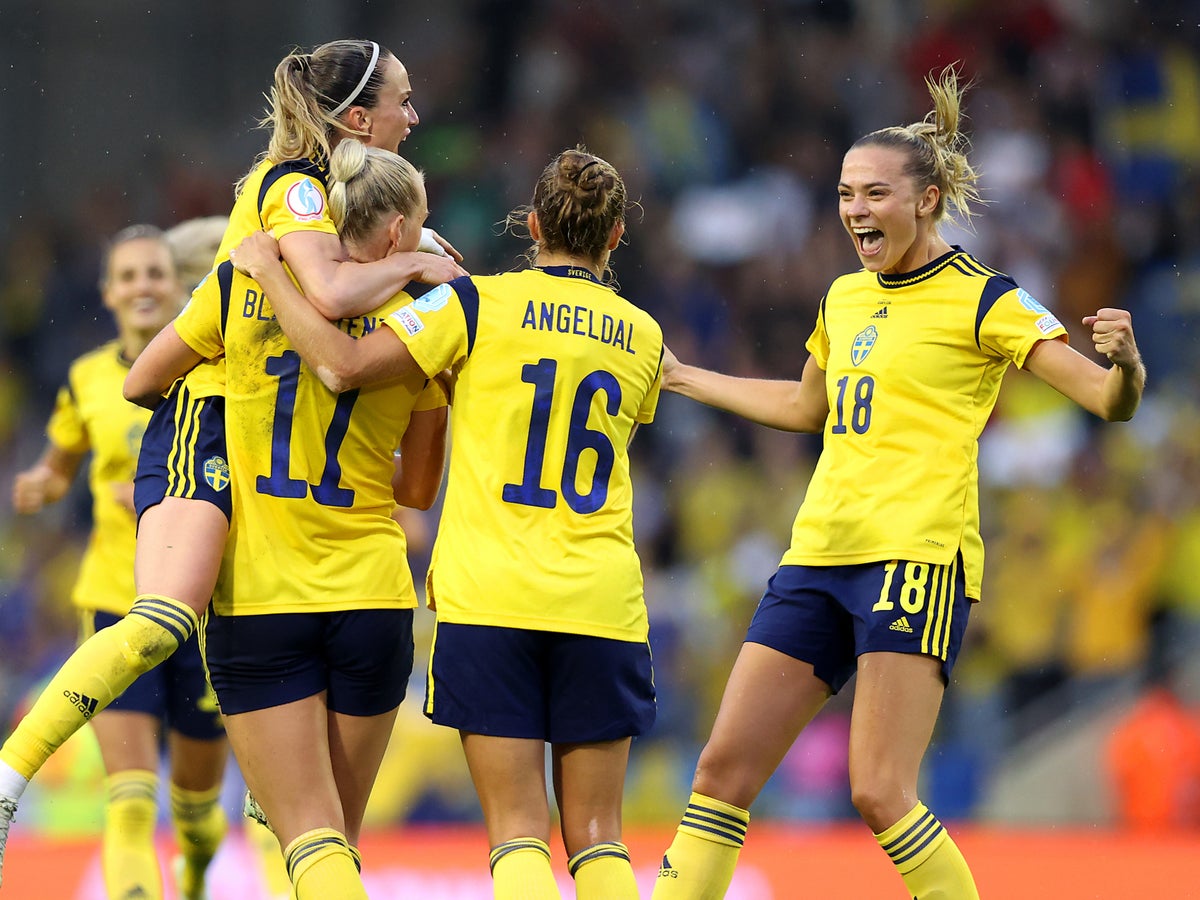
If England want to know how to beat Sweden, they can just ask Sweden. In fact, they can just Google it.
Type “how to beat Sweden” into your search bar and the top result will be howtostopsweden.com, a promotional campaign for the yellow and blue kit that the Blagult are wearing at this Women’s European Championship. On there, you will find a 26-page tactical report – written by Anders Eriksson, the national team’s own match analyst – which breaks down and examines their attack, their defence and each player in the squad, the idea being to reflect Sweden’s “openness and transparency” as a nation.
Of course, this is a cute and original marketing stunt to flog Adidas shirts rather than a foolproof blueprint to get the better of the highest-ranked side in the tournament. As you might expect, a lot of the advice focuses on how to best prepare for Sweden’s strengths rather than how to exploit any weaknesses. England’s own analysis, led by Sarina Wiegman’s technical staff, will be far more thorough and useful in that regard.
Still, the report is a helpful guide to what the Lionesses can expect from their semi-final opponents on and off the ball, as well as the individual threats they will face. “First of all, since Sweden is one of the fastest playing teams in the world and also one of the very best at counterattacking, do everything you can to reclaim the ball once you lose it,” it begins, offering the first hint into how this will be a different proposition to the quarter-final against Spain.
After being forced to play without the ball for the first time at this tournament last week, England will see more of it at Bramall Lane. All four of Sweden’s outings have ended with almost equal splits in possession – even their own, rather one-sided quarter-final against Belgium on Friday night, when chance after chance went begging until Linda Sembrant’s stoppage-time winner.
Though they eventually broke Belgium down, Sweden have generally looked more comfortable with space to play into. Denying them that space will be key.
Yet even then, they can hurt you in dead ball situations. “Sweden has an impressive 35 per cent shot ratio on set plays,” writes Eriksson, “so make sure to close down running lanes and slow down Sweden’s attackers.” Set-piece goals made up a chunk of the 40 scored during qualifying, while three of the five put past Portugal in the final round of group stage games came from corners, with Filippa Angeldal profiting twice by lurking on the edge of the penalty area. Stina Blackstenius saw another disallowed for offside from a free kick.
England will not even be safe when they have the ball themselves and will need to stay alert to the threat of Sweden’s counterpressing. Peter Gerhardsson, their head coach, wants his players “to press defensively from the front and force opponents to play into traps where they can win the ball and immediately counterattack,” according to his video analyst. That is borne out by the numbers this summer: no team at this Women’s Euros has won more turnovers high up the pitch or pressed more successfully in general.

While Sweden have struggled to convert these opportunities into shots and goals, the potential is there to prey on one of England’s few weaknesses. Spain had some joy pressing high and wrecking the Lionesses’ build-up, particularly in the first half. Austria briefly did the same during the opening stages of the curtain raiser at Old Trafford. England eventually found their composure on both occasions and may need to do so again. Everything about Sweden’s style points to them attempting to press and disrupt.
That’s the team, then. As for Sweden’s many talented individuals, Fridolina Rolfo is perhaps the greatest single threat to England’s hopes of reaching the Wembley final. Described as a “one of a kind world class forward”, Rolfo was one of the stand-out performers of last year’s Olympics and has the highest xA of any player in Sweden’s squad at this tournament. “Try not to give her the time and the space to shoot from outside the box,” the report helpfully suggests.
Rolfo is likely to be up against Lucy Bronze, her Barcelona teammate from next season. Once widely regarded as the best right back in the world, Bronze’s star has fallen slightly of late and she has admitted to feeling targeted at this tournament. Her battle with Rolfo could be decisive. Even if Bronze is successful, that could easily lead to the Swede switching flanks and facing off against Rachel Daly, who is far from a natural left back and looked vulnerable before being taken off against Spain.
Rolfo is far from the only threat. Kosovare Asllani has arguably been Sweden’s most impressive player at this tournament and currently leads the assists charts, just as she did in qualifying. Make her “play facing her own goal”, is the report’s recommendation. Blackstenius’s six months in an Arsenal shirt have shown the danger she poses. “Whatever you do, don’t allow her to reach the ball inside the penalty area,” is the advice. Indeed, the more you read about how to beat Sweden, the more difficult to beat they seem.
Maybe it should be no surprise then that they remain undefeated at this tournament and are slowly, steadily building momentum. England will be confident of reaching their first major tournament final in 13 years but, despite supposedly revealing their secrets to the world, Sweden are not about to make things that easy for them.







